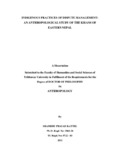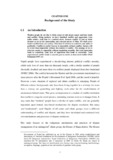Please use this identifier to cite or link to this item:
https://elibrary.tucl.edu.np/handle/123456789/2776| Title: | Indigenous Practices of Dispute Management: An Anthropological Study of the Kisans of Eastern Nepal |
| Authors: | Kattel, Shambhu Prasad |
| Keywords: | Disputes;Study;Management |
| Issue Date: | 2011 |
| Publisher: | Central Department of Anthropology |
| Abstract: | This is an ethnographic study of political organization and practices of justice delivery system among Kisan community from a political anthropological perspective. The study analyses “indigenous practices of dispute management" particularly structure and functions of community court, access of common people to the court, strength and weakness of dispute management body, interrelationship between informal and formal forums and changes realized in the political organization of the community. The Kisan is a minority ethnic group of Tarai and have been living in Jhapa district for more than 7 generations. The total population of the Kisans is 773 with 380 male and 393 female. As a closed community, Kisans live in clustered settlements closer to the forest and a river and are generally involved in agricultural farming for subsistence. The study explored distinct socio-cultural and political practices of this community. They are organized under an indigenous political organization which is known as Baiga System. The Baiga system is well structured and it appears similar to the government machinery of a state. The indigenous organization of the community runs an effective and well-functioning community court which is locally known as Kachchheri. The community government and the Kachchheri are run by specialized authorities such as the Mahato, Wakil and Sipahi. The Kachchheri has two layered structure such as Community Court and Village Court. The Mahato is the Chief Judge, Wakils are the Judges and the Sipahis are the assistants of the community court. The Sipahi is the village head as well as Chief Judge of the Village Court who also appoints volunteers for enhancing village justice (there are nine villages and Sipahi in the study area). Due to the availability of the services of Community Court and its specialized authorities, almost all community disputes are resolved immediately in the community. The Kisans do not go to formal forums to resolve any kind of intra-community problems. The Kisans claim that their origin and history is linked with the Nagbanshi Raja (Nagbanshi or Nagasia King) of Chhotanagpur of Madhyapradesh in India. Chhotanagpur was under the rule of Nagasia tribe from ancient to medieval period (500 to 1600AD) which was invaded by the Muslim rulers (Vidyarthi and Rai 1985). A group of the Nagasia tribe arrived in Jhapa district with their followers during 18th century and settled there as farmers. The descendents of Nagasia settlers are known as Kisan today in Nepal while the original group is still known as Nagasia in India. The study has shown that there are close socio-cultural and political ties between the Kisan of Nepal and Nagasia of India. The group is known as Kisan in Nepal because of their farming profession. The Community Court is found influential and accessible to all members of the community. It does not follow any formal procedures. The Kisan court resolves community disputes along with the formal forums set up by the state. It has recently established a relationship with local police offices in order to seek their services in resolving criminal cases from within the community. The study also fond out the processes of dispute management in the Kisan court, especially participation / accessibility of gender and common people and its effectiveness or strength in the community. It has also explored the contributions of the Kisan Court in dispute resolution in comparison to the formal forums of dispute resolution in Nepal (District Court, VDC, Police Office, and so on). The Kisans are organised under the Mahato, the chief of Baiga System. The Mahato is not only considered the chief of the Baiga system and the community but is also recognised as a living representative of the god and goddess, the ancestors, controller of the earthly resources and representative of super natural power. Such a powerful leader of the community and his lieutenants are elected by the Kisan Community Assembly. The community organises community assembly periodically to elect their authorities (Mahato, Wakil, Sipahi), to pass laws and to settle community issues. The Mahato is hereditary even though the assembly decides on his successor by considering his leading capacity, soberness, and sense of responsibility in preserving and protecting their culture. Such a powerful leader, the Mahato, has no rights to declare his successor. The Community Assembly deserves the rights to terminate the working chief and elect a new chief. Due to effective services of the Kisan community court none of the community members has gone to formal forums for resolving their dispute until this study. The study found that the community court is easily accessible to all community members. There is no undue delay in giving verdict, its services are not very expensive for the clients and its procedures are simple and non-formal. It resolves a case immediately and implements the decision. It follows simple but systematic procedures of dispute resolutions; brings the disputants together at the end of the session and reintegrates them. Moreover, it assigns the responsibility to the concerned village Sipahi for implementation of the agreement. Therefore, chances of repetition / appellation of a case are very less in the Kisan court. The Kisan Court has registered 429 disputes and resolved 347 (81%) disputes whereas the Police Office received 682 disputes and settled 417 (61%), District Administration office received 589 disputes and settled 479 (81%), District Court, Jhapa received 1198 disputes and resolved 658 (55%), and VDC and Municipality received 1293 disputes and resolved 893 (69%) disputes in 2008. Out of the total settled cases in different formal forums in 2008, the Kisan Court itself has settled 12% cases. The community has been influenced by non-Kisan migrants, development activities and modern market forces in recent years. In the interface with new situation, most of the Kisans have lost their productive land and resources and changed into daily wage labourers. The multiparty politics has also attracted community members to different political parties. Some of the young and educated Kisans have established an NGO (club) for dealing with the processes of socio-cultural change and community development. However, the Baiga system is effectively functioning in the community though it has some impacts of the present change and modernization. |
| URI: | http://elibrary.tucl.edu.np/handle/123456789/2776 |
| Appears in Collections: | Sociology |
Files in This Item:
| File | Description | Size | Format | |
|---|---|---|---|---|
| Cover.pdf | 70.6 kB | Adobe PDF |  View/Open | |
| Chapter.pdf | 1.14 MB | Adobe PDF |  View/Open |
Items in DSpace are protected by copyright, with all rights reserved, unless otherwise indicated.
